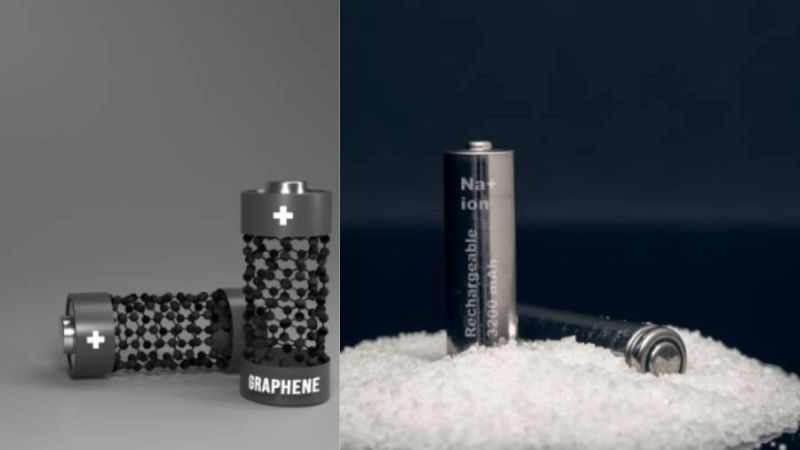The race to develop advanced battery technologies for electric vehicles has led to the emergence of sodium batteries and graphene batteries as potential contenders. In this comprehensive comparison, we examine the key factors of energy density, charging speed, the practicality of commercialization, and future promise to evaluate which technology holds the most potential for the automotive industry.
Energy Density:
Energy density is a critical factor determining the driving range of electric vehicles. Sodium batteries typically offer lower energy density compared to graphene batteries. Graphene's unique properties, such as its high surface area and exceptional electrical conductivity, enable higher charge storage and result in superior energy density, giving graphene batteries an edge.

Charging Speed:
Efficient charging is crucial for electric vehicles' practicality and widespread adoption. Graphene batteries exhibit faster-charging capabilities due to graphene's high electrical conductivity, allowing for rapid electron transfer during charging and discharging processes. While capable of decent charging rates, sodium batteries generally lag behind graphene batteries regarding charging speed.

Practicality of Commercialization:
Commercial viability is a significant consideration for any emerging technology. Sodium batteries have an advantage in practicality and commercialization due to sodium's abundance and low cost compared to other rare materials. However, sodium batteries are still in the early stages of development and face challenges related to cycle life and stability. Graphene batteries, although more expensive to produce currently, hold promise due to graphene's scalability and compatibility with existing manufacturing processes.

Safety and Environmental Considerations:
Both sodium batteries and graphene batteries offer improved safety compared to some lithium-ion batteries. Sodium is less prone to thermal runaway, while graphene's stable carbon-based anode enhances safety. Additionally, sodium and graphene are more abundant and environmentally friendly compared to some materials used in other battery technologies.
Future Promise:
While sodium batteries show potential for large-scale energy storage systems due to their cost-effectiveness and safety, graphene batteries exhibit remarkable potential in portable electronics, electric vehicles, and renewable energy storage. Graphene's high energy density, fast charging, and compatibility with existing infrastructure position it as a promising candidate for the future of electric mobility.
Conclusion:
In this comparison, graphene batteries outperform sodium batteries regarding energy density and charging speed. However, sodium batteries have advantages in terms of practicality and commercialization due to their cost-effectiveness and abundance. Both technologies show promise in different applications and may significantly advance the electric vehicle industry. As research and development continue, further advancements will likely be made to enhance the performance, safety, and commercial viability of sodium and graphene batteries, paving the way for a more sustainable and efficient future of transportation.
Thank you for embarking on this journey with us. Together, let's continue exploring, discovering, and unlocking new horizons. Stay tuned for more captivating content to fuel your curiosity and inspire your imagination. We appreciate your readership and look forward to you joining us on our next adventure. Until then, keep dreaming, reading, and coming back for more!
Also, watch Toyota suddenly bringing its BZ4X electric SUV concept to the United States on Torque News Youtube channel, and please subscribe to us on Youtube and follow on Twitter for daily Toyota and EV news reports.
Image source: Peter Neilson
Peter Neilson is an automotive consultant specializing in electric cars and hybrid battery technologies. He holds a Bachelor of Science in Automotive Service Technology from Weber State University. Peter can be reached on Linkedin and you can tweet him at The_hybrid_guy on Twitter. Find his page on Facebook at Certified Auto Consulting. Read more of Peter's stories at Toyota news coverage on Torque News. Search Toyota Prius Torque News for more in-depth Prius coverage from our reporter.












Comments
As always another journalist
Permalink
As always another journalist only mentions a negative aspect of sodium ion batteries - their still relatively low energy density. The same was repeated ad nauseam about LFP(Lithium Iron Phosphate) batteries. But thanks to China's rapid innovators(BYD, CATL etc) over half of Tesla's Model 3's and Model Y's for instance are now LFP-powered - and all offer EPA ranges over 270 miles. And sodium ion cells offer other major advantages - they are for instance very heat-stable and can typically be charged from 20%-80% in 15-30 minutes. They can also operate at extreme cold-hot ambient temperatures - from -30C to +50C. And of course sodium is extremely cheap and ultra-abundant compared to lithium. One cubic metre of seawater for instance contains 35kg of salt/sodium chloride..the world's oceans contain trillions of tonnes of it.
Paul G
Thank you for the reply. It
Permalink
In reply to As always another journalist by Paul GOVAN (not verified)
Thank you for the reply. It certainly is good having others out there who can help with giving more detail about the emerging market and share more about these technologies.